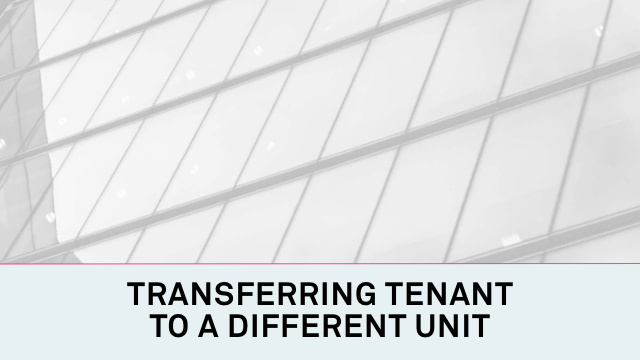Apartment investing is all about generating positive cash flow. In order to generate cash flow, units need to be rented!
Minimizing vacancy is one of the most important jobs of property managers. Industry insiders often refer to this as putting “heads in beds”.
Some property managers will simply lower the rents to re-lease units quickly (to get those heads in beds). Others will take a more thoughtful approach to reduce downtime without lowering rents.
In this article, we look at 9 tips for saving time and money when re-leasing apartments.
1. Ensure you are keeping a close eye on market conditions
Too often, owners lease their rental property and once stabilized, stop paying attention to market conditions. Market conditions are always changing. This is true at both the micro and macro level.
At the local level, a new apartment community may be coming online that will directly compete for your tenants. At a macro level, economic conditions for example may impact what tenants are willing to pay for rent.
It is important for owners to watch the market continuously. This way, when a tenant moves, they can adjust their plans accordingly.
This could be a case where the market is hot and a unit has little wear and tear. In these situations, apartments may only need a light refresh before re-leasing for top dollar.
In other cases, like if competing with new product. An owner might use this as an opportunity to quickly mobilize and make more substantial unit improvements.
2. Stock up on “standard” supplies (e.g., paint, fixtures, appliances)
Property managers can save time when they know what color paint, carpet, and appliances are needed. Landlords should consider standardizing their units with the same paint scheme, lighting, and flooring.
That way you don’t need to spend time matching paint colors. Especially when trying to save time before a new tenant moves in. This can shave a few days off the apartment turnover process.
Some property managers will bulk purchase supplies and store them somewhere on site (or close by). This is so when a unit becomes vacant, they don’t need to worry about finding the right supplies. Everything they need will already be available.
Stocking up avoids having to deal with supply chain issues that have been so disruptive over the past two years!
This is the best way to tackle light wear and tear before a new tenant moves in. If there’s more than just routine wear and tear. Make sure to take pictures so you can deduct the repairs from the tenant’s security deposit.
3. Utilize pre-leasing strategies
Leasing efforts should begin as soon as a tenant notifies you that they won’t be resigning the lease. Ideally, pre-leasing efforts will result in very little (if any) apartment downtime.
For example, a tenant tells you on April 1st that they won’t be resigning their lease, which expires on August 31st. You can use the next few months to get tenants interested in moving in on September 1st. Or shortly thereafter.

Pre-leasing strategies include showing the unit while it is still occupied by the current tenants. Most leases will contain a provision that allows the owner to do so. Be sure to give current tenants appropriate notice (at least 24-48 hours, if not more).
If your apartment is located in an area with high demand. You might spend 2-3 weeks advertising on various websites and then host an open house.
The open house model. While it is often traditionally used for homes for sale, can also be used for rentals.
Leasing efforts should begin as soon as a tenant notifies you that they won’t be resigning the lease.
This open house model is a great pre-leasing strategy because it saves time and is less disruptive to current tenants. if the tenants know they’ll only need to have people in their unit once. They’re more likely to cooperate by cleaning up the unit in advance.
4. Focus your efforts on tenant priorities (e.g., apartment turnover cleaning)
If you’re trying to rent a unit quickly it is important to consider the things that tenants pay the closest attention to. For example, the quality of kitchens, bathrooms, and the living area. If you do not have the resources to spruce up these areas, focus instead on cleanliness.
Some people will lease an outdated unit. However, this doesn’t change that they want to feel good about moving into a place that is especially clean.
It is important to ensure you do not skimp on deep cleaning after a tenant moves out.
Deep cleaning also sends a message to the tenants that you care about the property. It sets the expectation that they should care for their apartment, too.
If your team cannot accommodate a thorough apartment turnover cleaning (especially on short notice). It is best to be prepared to engage a third party professional cleaning service that can jump on this right away.
If you know when a tenant is vacating a unit, you should try to have a professional cleaning crew there within 24 hours. This saves time and money. Property managers can start showing the unit immediately after.
Related Link: Property Manager’s Apartment Turnover Checklist
5. Clean up the yard and front entryways
For many prospective tenants, first impressions are everything. Even if you do not invest in new landscaping. Ensure that the area from the driveway to the doorway and lobby is clean. This is making sure that leaves are raked, weeds are pulled, and hedges have been trimmed.
Some property managers may be doing showings at dusk or in the evening. It is important to make sure that parking, walkways and front door are all properly lit. Ensure that the front entryway is also clean. Make sure the area is free of any clutter or blockage.
Lack of cleanliness is not only unattractive to the tenants, but it is also a safety issue! Small touches, like hanging plants and a seasonal doormat, will also indicate that the property is well maintained.
6. Establish a process for self showings
Self showings have become increasingly popular as a result of the pandemic. A self showing is when the keys to a unit are left in a lock box or an electric keypad. Self showings allows prospective tenants to tour the property at their leisure.
Self showings reduces the need to coordinate with showing agents or property managers. Self showings can save substantial time and money.
The benefit to self showings is it allows people to tour the unit whenever it’s best for them. It also removes any pressure by agents to fill out an application on the spot.
What should you consider if you plan to utilize self showings?
- Self showings are best utilized at single family rentals or large apartment communities. They can be more disruptive at 2-10 unit apartment buildings. As this is where tenants are less accustomed to strangers coming in and out of the building.
- It is important to pre-screen tenants before allowing a self showing. The best practice is to take a copy of the prospect’s license. That way you are able to put a temporary hold on their credit card. This is to protect against any damage they may cause while on site.
- Rather than leaving keys in a lock box, some owners prefer using keyless entry systems. Some locks allow the owner to give people temporary codes. The code will only be valid for a certain period of time, e.g. Tuesday from 6-8pm. This ensures that the prospect can only access the unit when they have stated they will be there. A “smart lock” like this can also track exactly when the unit was accessed.
- The downside to self showings is that there are no property managers on site. This makes it difficult to answer any questions the prospects may have. You should always have an agent available by phone during the self showing. This allows the renters to ask questions if need be.
- Following up after a self showing is an essential step to securing the tenant. Property managers should immediately contact the prospects to see if they have questions or if they’re interested in moving forward. If so, the owner/agent/property manager should be able to send electronic documents immediately to get the process going. Time is of the essence!
7. Have solid screening processes in place
One way to save yourself headaches is by pre-screening tenants prior to showing the unit. Be sure the prospective tenants meet your company’s criteria.
If you screen people in advance, this reduces unnecessary showings to people who won’t ultimately qualify. For example, some landlords require people to earn 3x the monthly rent and have a credit score about 650 to qualify.
This is also a good time to subscribe to any software applications or services you plan to use to screen tenants. There are various programs that owners can use to run credit checks, verify employment, and rental history.
When a prospect is interested in your multifamily apartment, you can move quickly. That saves time and money as you try to fast track apartment turnover.
8. Utilize technology for signing leases and collecting security deposits
The days of paper leases and writing physical checks are long gone. In most cases, tenants prefer to utilize technology for all rental communication, paperwork, and money exchanges.
Thankfully, there are several well vetted multifamily property management software programs. These programs are specifically designed for multifamily landlords and property owners. Providing them with a significant range to choose from these days. Some of the most popular programs include:
- Avail provides a free service for owners of multifamily apartment buildings. Once tenants are interested in a unit, the program can automatically send them a rental application. The application asks them about their employment, resident history, and more.
Owners can also run a TransUnion credit check directly through Avail. Assuming all looks good, landlords can use Avail to complete leases and collect security deposits and rent payments. Avail also allows owners to continue communicating with their tenants post occupancy. Many owners will use the software to track repair and maintenance requests, too.
- TenantCloud is a software that allows owners to do many of the same things as Avail and at no cost. Those who opt for a paid membership will have access to other benefits as well. For example, a paid TenantCloud membership allows owners to create their own customized websites to help advertise their multifamily properties.
TenantCloud has also partnered with Rentler to send owners tenant leads. TenantCloud’s communication and maintenance program is also slightly more sophisticated. For instance, tenants can attach pictures to their maintenance request. The landlord can then upload their own pictures to verify the work has been completed.
- PayRent is a more focused software program. It is exclusively focused on rent payments and manages this process incredibly well. PayRent can collect payments, including security deposits, through both ACH/debit cards AND credit cards.
This is a unique feature as not many programs offer credit card payments. Therefore, this is a particularly unique feature. The program tacks on a 3.5% surcharge for any tenant paying by credit card. This ensures landlords do not incur credit card processing fees. PayRent also automatically sends invoices, payment reminders, past due notices, late fees, and receipts. Landlords of multifamily properties have access to a sleek dashboard. This is where PayRent summarizes upcoming charges/payments, outstanding balances, security deposit deductions, and more.
- AppFolio is a web based property management application that is widely used by apartment owners. Our property managers and leasing agents use Appfolio here at Smartland.
AppFolio centralizes many property management functions. This is including but not limited to tenant screening, online lease agreements, rent collections, security deposits, and work orders. AppFolio has a sleek, user friendly interface that makes it easy to manage multifamily housing of all kinds. It also has a free plan. However, most property managers opt for the paid plans due to the software’s capabilities. Pricing is on a per unit, per month basis. This is with some of the most competitive rates of all platforms featured here today.
9. Always prioritize renter retention
While it is important to do apartment turnovers quickly, the best way to minimize vacancy is by keeping existing tenants in place. Those individuals who own apartment buildings should always start by focusing on renter retention.
There are many small things property managers can do to keep renters happy.
The first is clear, effective communication. Tenants want property managers to be responsive. If they reach out with a question or concern, be sure to respond within 12-24 hours (the sooner, the better).
Clear, effective communication is one of the
important things that property managers can try
to do to keep renters happy.
Even if you cannot address the problem right away, it is important to respond quickly telling them that you have received the message and are working on an answer/solution.
Second, take repair and maintenance requests seriously. If a tenant were to tell you that their toilet is running, make sure to have a property manager or plumber respond within 24 hours to address the problem. Not only does this resolve the issue, but it prevents larger issues from happening.
For example, if that toilet continues to run, it may cause a leak into the unit below. Now you’re dealing with a toilet, a leak, and potentially ceiling damage across multiple units.
To ensure you are saving yourself the trouble, take action by being highly responsive to R&M requests.
Finally, it is important to pay close attention to detail. Take the time to make small gestures.
If you have a small apartment building, consider buying each unit a pie at Thanksgiving. This is a simple way of showing your gratitude that they’ve chosen to make their home with you.
At larger apartment communities, you might decide to host free social gatherings from time to time.
These are cost effective things that can go a long way in keeping tenants happy. Those happy tenants are always more likely to move forward in renewing their lease year after year!
Conclusion
Each day a unit sits vacant, is a day of foregone income. If a unit sits vacant for any stretch of time, that can virtually wipe away the profits.
Owning multifamily apartments can be an
excellent investment strategy. However, the key is
maximizing cash flow and profitability.
Having processes in place to turnover units quickly is essential for minimizing vacancy. In today’s market, where rentals are in short supply. Units must be re-leased quickly after a tenant moves out. Thoughtful owners will have the apartment turnover process down to a science.
FAQs
What’s the fastest way to cut vacancy?
Start early. Track market conditions and begin pre-leasing as soon as a resident gives notice so there’s little or no downtime between tenants.
What should I have ready before move out?
Standardize finishes and stock make ready supplies (paint, fixtures, common appliances) so crews can turn units without delays or supply hiccups.
How should I prep the unit between tenants?
Focus on what prospects notice most and deep clean. If possible, get a professional crew in within 24 hours so you can start showings immediately.
Do self showings really help?
Yes, they widen showing windows and save time, but use guardrails: pre-screen prospects, consider smart locks with temporary codes, keep an agent reachable by phone, and follow up immediately.
How do screening and tech speed things up?
Pre-screen to avoid unqualified tours, then use property management software to run checks, e-sign leases, and collect deposits and rent online.
What’s the best way to avoid frequent turnovers?
Prioritize resident retention with quick communication, fast maintenance response, and small gestures that show you care. Happy residents renew.



